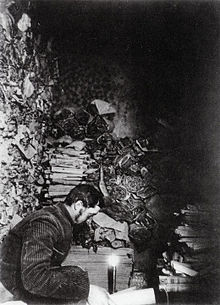- Old Tibetan Chronicle
-
Part of a series on Tibetan Buddhism
History Timeline · Related-topics Schools Nyingma · Kagyu · Sakya · Gelug · Bön · Jonang Key concepts Three marks of existence · Skandha · Cosmology · Saṃsāra · Rebirth · Bodhisattva · Dharma · Dependent origination · Karma Major figures Gautama Buddha · Padmasambhava · Je Tsongkhapa · Dalai Lama · Panchen Lama · Lama · Karmapa Lama · Rinpoche · Geshe · Terton · Tulku Buddhahood · Avalokiteśvara · Four stages of enlightenment · Tantric yoga · Paramitas · Meditation · Laity Changzhug · Drepung · Dzogchen · Ganden · Jokhang · Kumbum · Labrang · Mindroling · Namgyal · Narthang · Nechung · Pabonka · Palcho · Ralung · Ramoche · Sakya · Sanga · Sera · Shalu · Tashilhunpo · Tsurphu · Yerpa Chotrul Duchen · Dajyur · Losar · Monlam · Sho Dun Texts Kangyur · Tengyur · Tibetan canon · Mahayana sutras · Nyingma Gyubum Sand mandala · Thangka · Ashtamangala · Tree of physiology Outline · Comparative studies · Culture · List of topics · Portal
The Old Tibetan Chronicle is a scroll containing 536 lines, however the end is missing. There are Chinese Buddhist texts on the reverse side of the scroll. It was discovered along with other manuscripts written in Old Tibetan language, including the famous (Old) Tibetan Annals, found in the early 20th century in the so-called "hidden library", the Mogao Grottoes near Dunhuang, which is believed to have been sealed in the 11th century CE. They form Tibet's earliest extant history.[1]
Contents
Discovery
An enormous number of early manuscripts in a variety of languages were collected by Aurel Stein and Paul Pelliot at the famous sealed-up Library Cave (no. 17) of the Mogao Grottoes and sent back to London and Paris respectively. Among these Dunhuang manuscripts, were found along with the "Old Tibetan Chronicle", which was probably compiled between 800-840 CE. and The Tibetan Annals (or "Tibet’s First History").[2]
The manuscript containing the Chronicle is Pelliot tibétain 1287 in the Paul Pelliot Collection at the Bibliothèque Nationale in Paris. It is made up of two different strips of paper with a total length of 6.2 metres (20.3 feet). The first strip of thin paper contains the first six chapters that Pelliot and his team made of the text. The second strip, made of strong paper, contains the other four chapters.[3]
Contents
The Chronicle, largely fictitious, begins with the reign of King Drigum Tsenpo, the seventh king in the genealogy given in Ms. 249, (and, although originally coming from the sky, like the previous kings, he was the first to be buried on earth). The Chronicle then continues up to and including the reign of king Tridu Songtsen (670–704; r. 676–704 CE). The account of the latter king is confused as it contains material clearly from the reign of Songstan Gampo.
The Chronicle plainly attests to a well-organized feudal society with an established hierarchy and rites in Tibet from the middle of the 6th century CE. The boldness and skill of the policies of the emperors of the 7th and 8th centuries are plain to see.
For some reason the important conquest of the Chinese Four Garrisons of Anxi in 670 is not mentioned and neither is the emperor Mangsong Mangtsen (650-676) under whom these conquests were made.[4]
Neither the Annals nor the Chronicle make any mention of Buddhism in the reign of Songtsan Gampo.[5] However, the Chronicle does say that, during the reign of king Khri srong lde brtsan (Trisong Detsen) (r. 755-ca.797 AD.), "The incomparable religion of the Buddha had been received and there were viharas (monasteries) in the centre as well as the borderlands of the country."[6]
Footnotes
- ^ Dotson (2009), p. 9.
- ^ "Forward" by Per Sørensen in (Dotson (2009), p. 1.)
- ^ Bacot, Thomas and Toussaint (1940-1946), pp. 93-95.
- ^ Bacot, Thomas and Toussaint (1940-1946), p. 94.
- ^ "Preface to the Asianart.com edition of this article." By Amy Heller, Jan 21, 2007.
- ^ Bacot, Thomas and Toussaint (1940-1946), p. 153.
References
- Bacot, Thomas and Toussaint. (1940–1946). Documents de Touen-houang relatifs a l'histoire de Tibet. J. Bacot, F. W. Thomas, Ch. Touissant. Paris. Libraire orientaliste Paul Geunther.
- Beckwith, Christopher I. The Tibetan Empire in Central Asia. (1987). Princeton University Press. ISBN 0-691-02469-3.
- Choephel, Gedun. (1978). The White Annals. Library of Tibetan Works & Archives Dharamsala, H.P., India.
- Dotson (2009). Brandon Dotson. The Old Tibetan Annals: An Annotated Translation of Tibet's First History. VÖAW, Austria. ISBN 978-3-7001-6102-8 (book); ISBN 978-3-7001-6712-9 (online edition).
External links
Categories:- Tibetan literature
- History of Tibet
- Tibetan historians
- Historical documents
Wikimedia Foundation. 2010.


